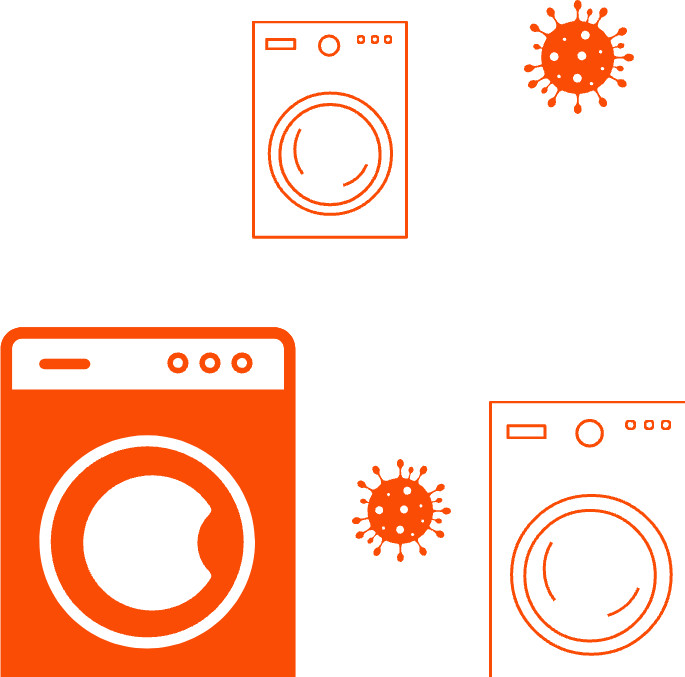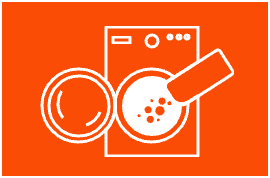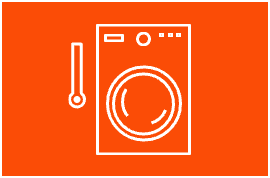During an average day, we're likely to pick up loads of bacteria and other germs from people and objects, some of which can be transferred to our clothes. On other days, we or someone in our household may have a respiratory virus or stomach bug.
In most cases, deep cleaning the laundry is enough to avoid the spread of germs and infections that can cause some illnesses, using a few extra precautions when handling laundry if you have suspected or confirmed COVID-19 disease, according to the COVID-19 guidelines. In other cases, you can only disinfect items that are difficult to wash or items between washes.
Important: Sometimes, when someone has a stomach virus, for example, it's important to know how to kill germs by disinfecting laundry. Read on to learn the difference between deep cleaning, disinfection, and disinfestation, and when and how to perform each.
The difference between deep cleaning, disinfection and disinfestation
Deep cleaning works by using a high-quality detergent, water and agitation to physically remove dirt, stains and germs from fabrics to be washed down the drain with the dirty water. Deep cleaning does not kill germs. Disinfection and disinfection products contain chemicals that kill germs. In general, disinfectants reduce the number of certain bacteria (up to 99.9 percent) to safe levels, while disinfectants kill bacteria and other germs such as viruses.

When and how to deep clean your laundry
If you take care of people with weakened immunity or if our household has infectious diseases, it is best to follow the advice of your doctor.
-
You can wash everyday clothes and shoes in cold water with an appropriate dose of high-quality laundry detergent.
-
Underwear, sportswear, towels and bedding may need an additional boost in cleaning power by washing in warm water (90°C or higher) with an appropriate dose of high-quality detergent.
-
To prevent damage to laundry items, be sure to check the washing and drying instructions on the care labels.
How to safely handle and wash laundry when someone is suspected or confirmed to have COVID-19
The Medical Chamber of Serbia also has guidelines and instructions on how to disinfect surfaces that may have been in contact with contaminated clothing. See detailed LKS guidelines :
-
Wash clothes according to the manufacturer's instructions. Use the hottest appropriate water setting and dry the garments completely.
-
Wear disposable gloves when handling the sick person's dirty laundry.
-
Dirty laundry of a sick person can be washed with other people's things.
-
Don't shake dirty laundry.
-
Clean and disinfect clothes baskets according to the instructions above for surfaces.
-
Take off your gloves and wash your hands immediately.
When and how to disinfect or disinfect laundry using the product
For laundry from people who may be sick with a stomach virus such as rotavirus, or for laundry heavily contaminated with body fluids, we suggest the following:
-
Always wash your hands following the guidelines when handling contaminated laundry; including after you transfer the clothes from the washer to the dryer.
-
Wash off excess body fluids with warm water and wash things immediately.
-
Consider washing in hot water or the hottest water allowed by the item's care label.
-
Use the appropriate dose of high-quality laundry detergent.
-
Repeat the cycle if stains or residues remain after washing.
-
Thoroughly dry the garments on the highest heat cycle allowed by the care label of the item.
Important: Do you have doubts about whether the clothes are safe to wash in hot water and/or with bleach? Don't guess. Check the care labels for specific washing instructions, and also check the instructions on the additive. First, test the color fastness on an inconspicuous spot following the instructions on the product label.
When and how to deep clean the washing machine
The condition of our washing machine has a significant impact on the cleanliness of the laundry. Regular cleaning of our washing machine is a simple process and should be done on a monthly basis.
To prevent odors from the washing machine that can transfer odors to our clothes, use a machine cleaner and follow the washing machine deep cleaning guide below:
Step 1

Step 2

Pour washing machine cleaner into the drum to remove detergent residue and laundry odors.
Step 3

Run the washer on a hot, empty cycle, put just the washer cleaner in to take care of the rest.
Advice corner
Here are some additional tips that will help you reduce the risk of spreading germs from soiled or contaminated laundry:
-
Always wash your hands for 20 seconds with soap and warm water after handling dirty laundry - even when transferring clothes from the washer to the dryer.
-
Take off your clothes in a room that has hard surfaces that are easy to disinfect, instead of piling dirty laundry on the bed, for example.
-
Cleans the laundry basket regularly. If it is made of fabric, wash it, and if it is plastic, wipe it with a disinfectant wipe.
-
Always use the appropriate dose of laundry detergent for the size and degree of contamination of the load in the machine.
-
Avoid overloading the washing machine.
- Wash heavily contaminated items of clothing separately on the hottest wash setting allowed by the care label - ideally with a registered disinfectant or disinfectant additive.
- Thoroughly dry the garments at the highest heat allowed by the care label.










30 comments
ckqkw0
zwhw8g
6tm89v
xn00ex
qskn0p